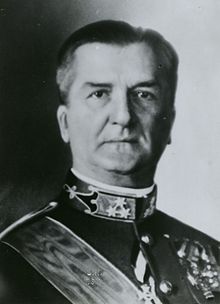Regent of Hungary
| Regent of Hungary | |
|---|---|
| Kormányzó | |
 | |
| Style | His Serene Highness |
| Residence | Buda Castle |
| Appointer | Royal Diet |
| Term length | No fixed term |
| Formation | 1446 (historic) 1 March 1920 |
| Final holder | Miklós Horthy |
| Abolished | 15 October 1944 |
| Deputy | István Horthy (19 February – 20 August 1942) |
The regent of Hungary was a position established in 1446 and renewed in 1920. It was held by Admiral Miklós Horthy until 1944. Under Hungary's constitution there were two regents, one a regent of the ruling house, called the Nádor, and another called "Kormányzó" (which can mean "governor"). As the Entente had banned the legitimate Nádor from taking his place, the choice fell on electing a governor-regent: Admiral Horthy was chosen. Thus, he was regent of the post-World War I state called the Kingdom of Hungary and served as the head of state in the absence of a monarch, while a prime minister served as head of government. Horthy was styled "His Serene Highness the Regent of the Kingdom of Hungary" (Hungarian: Ő Főméltósága a Magyar Királyság Kormányzója).
History of the position
Historical examples
John Hunyadi

On the untimely death of
At the
, Hunyadi's difficulties elsewhere compelled him to make a truce with Frederick for two years.Mihály Szilágyi

On 20 January 1458,
Lajos Kossuth

During the
After World War I
Upon the dissolution and break-up of
On 1 March 1920, the National Assembly of Hungary re-established the
Bishop Ottokár Prohászka then led a small delegation to meet Horthy, announcing, “Hungary’s Parliament has elected you Regent! Would it please you to accept the office of Regent of Hungary?” To their astonishment, Horthy declined unless his powers were expanded. As Horthy stalled, the politicians folded, and granted him "the general prerogatives of the King, with the exception of the right to name titles of nobility and of the patronage of the Church." Those prerogatives included the power to appoint and dismiss prime ministers, to convene and dissolve parliament, and to command the armed forces. With those sweeping powers guaranteed, Horthy took the oath of office.[2] (King Charles did try to regain his throne twice; see Charles IV of Hungary's attempts to retake the throne for more details.)
Functions
The Hungarian state was legally a kingdom, but it had no king, as the Allies of World War I would not have tolerated any return of the Habsburgs. The country retained its parliamentary system following the dissolution of Austria-Hungary, with a prime minister appointed as head of government. As head of state, Horthy retained significant influence through his constitutional powers and the loyalty of his ministers to the crown.[3] Although his involvement in drafting legislation was minuscule, he nevertheless had the ability to ensure that laws passed by the Hungarian parliament conformed to his political preferences.
End of the regency
During
After
Szálasi led the Government of National Unity from 15 October 1944 to 28 March 1945. The Hungarian parliament approved the formation of a Council of Regency (Kormányzótanács). On 4 November 1944, Szálasi was sworn in as the "National Leader" (Nemzetvezető), so he became the head of state in addition to being the head of government as Prime Minister of Hungary.[7] While the Horthy regency had come to an end the Hungarian monarchy was not abolished by the Szálasi regime. The need for a regent, or a regency, ended when the Kingdom of Hungary was replaced by the Second Hungarian Republic on 1 February 1946.
See also
- King of Hungary
- List of rulers of Hungary
- List of heads of state of Hungary
References
- ^ "Die amtliche Meldung über den Rücktritt" (in German). Neue Freie Presse, Morgenblatt. 1919-08-24. p. 2.
- ^ Sakmyster, Thomas L. (1994). Hungary's Admiral on Horseback: Miklós Horthy, 1918-1944. East European Monographs. p. 56.
- ^ Deak, Istvan, "A Fatal Compromise? The Debate Over Collaboration and Resistance in Hungary", in The Politics of Retribution: World War II and Its Aftermath, edited by Deak, Gross, and Judt, Princeton University Press, pp. 39–52
- ^ Earl F. Ziemke, Stalingrad to Berlin: The German Defeat in the East, U.S. Government Printing Office, 1968
- ISBN 963-07-5386-3.
- ISBN 0-9665734-3-9.
- ^ Hungary: Notes - archontology.org


